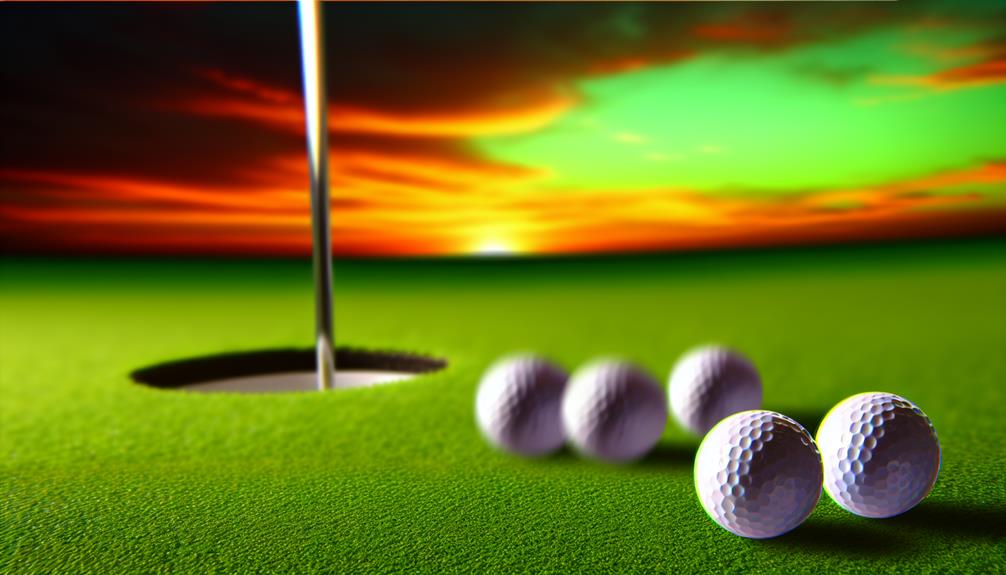Is it really possible that the right golf ball can dramatically improve your putting practice? You've probably heard the theory, but let's dissect the facts together.
As a serious golfer, you know that equipment plays a significant role in your performance. In particular, the golf ball can be a game-changer. Selecting the best golf ball for putting practice can be a minefield with so many options out there.
We're about to explore three top contenders that could make all the difference, but keep in mind, the perfect golf ball for one might not be the same for another, so why not stick around and see which one might just be your game-changer?
Review of Top Performing Putting Golf Balls
Now, let's delve into the details of the top-performing putting golf balls that can significantly improve your game. Ball durability is a critical factor to consider. You don't want a ball that wears out quickly, diminishing its performance over time. A durable ball will maintain its spin, distance, and feel, round after round.
Brand comparison is also key. Top brands like Titleist, Callaway, and Bridgestone each offer balls with unique performance characteristics. Titleist's Pro V1, for instance, is renowned for its consistent flight and extraordinary distance.
Callaway's Chrome Soft, on the other hand, is celebrated for its incredibly soft feel and excellent spin control, which can be a game-changer on the green. Bridgestone's Tour B RX, meanwhile, provides a good balance between distance and feel.
Don't just opt for a brand because it's popular. It's essential to find a ball that fits your specific putting style and overall game. Test different balls, analyze their performance, and choose the one that provides the best results for you.
Selecting the Ideal Golf Ball for Practice
When it comes to selecting the ideal golf ball for practice, it's crucial to consider your individual play style and the specific areas you're aiming to improve. Not every ball is created equal, and the one you choose can significantly impact your performance.
Ball durability is a key factor in your selection. You're going to be hitting this ball repeatedly, and a poor-quality ball may not withstand the level of practice you need. Look for a ball with a high durability rating; it'll last longer and give you a consistent performance throughout its lifespan.
Your practice environment also plays a significant role in your choice. Are you practicing on a professional course, or in your backyard? Different balls perform better in different environments. For instance, a soft, low-compression ball is great for backyard practice because it won't travel as far or cause damage. On a course, a high-compression ball might be better for replicating game conditions.
Lastly, consider the feel of the ball. You want a ball that's comfortable to hit, but also one that gives you a true sense of your swing's impact. A ball that suits your play style and practice environment will make your practice sessions more effective.
Impact of Golf Ball Design on Putting Precision
Building on the importance of selecting the right ball for your practice sessions, it's also crucial to understand how the design of a golf ball can drastically affect your putting precision. The design evolution of golf balls has seen a shift from simple, smooth spheres to complex, dimpled designs. These dimples aren't merely aesthetic; they're scientifically designed to decrease air resistance, allowing the ball to travel straighter and farther.
The material influence on ball design is equally significant. Today's golf balls are typically made from durable, high-performance materials like urethane and surlyn. Urethane balls, often preferred by professionals, have a softer feel and better spin control, enhancing precision on the green. Surlyn balls, on the other hand, are harder and more durable, providing higher speed but less spin control.
The design and material of a ball can impact its roll, bounce, and spin, affecting your putting precision. For instance, a softer, urethane ball with more dimples will typically provide better spin control, aiding in precision putting.
Therefore, understanding these factors and selecting a ball that complements your putting style can significantly improve your practice sessions.

